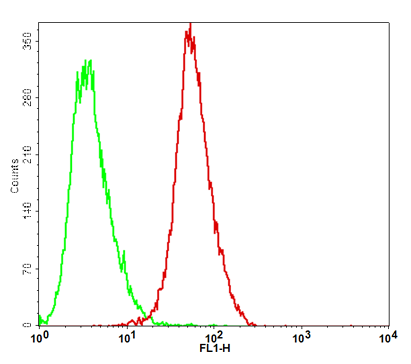FGFR4 Human, His
Shipping Info:
For estimated delivery dates, please contact us at [email protected]
| Amount : | 5 µg |
| Purification : | Greater than 90.0% as determined by SDS-PAGE. |
| Content : | FGFR4 protein solution (0.25mg/ml) contains Phosphate Buffered Saline (pH7.4) and 10% glycerol. |
| Storage condition : | Store at 4°C if entire vial will be used within 2-4 weeks. Store, frozen at -20°C for longer periods of time. For long term storage it is recommended to add a carrier protein (0.1% HSA or BSA). Avoid multiple freeze-thaw cycles. |
| AA sequence : | LEASEEVELE PCLAPSLEQQ EQELTVALGQ PVRLCCGRAE RGGHWYKEGS RLAPAGRVRG WRGRLEIASF LPEDAGRYLC LARGSMIVLQ NLTLITGDSL TSSNDDEDPK SHRDPSNRHS YPQQAPYWTH PQRMEKKLHA VPAGNTVKFR CPAAGNPTPT IRWLKDGQAF HGENRIGGIR LRHQHWSLVM ESVVPSDRGT YTCLVENAVG SIRYNYLLDV LERSPHRPIL QAGLPANTTA VVGSDVELLC KVYSDAQPHI QWLKHIVING SSFGADGFPY VQVLKTADIN SSEVEVLYLR NVSAEDAGEY TCLAGNSIGL SYQSAWLTVL PEEDPTWTAA APEARYTDLE HHHHHH. |
| Alternative Name : | Fibroblast Growth Factor Receptor 4, EC 2.7.10.1, JTK2, TKF, Tyrosine Kinase Related To Fibroblast Growth Factor Receptor, Hydroxyaryl-Protein Kinase, Protein-Tyrosine Kinase, Tyrosylprotein Kinase, CD334 Antigen, EC 2.7.10, FGFR-4, CD334, FGFR4. |
Source: Sf9, Baculovirus cells.
Sterile Filtered colorless solution.
Fibroblast growth factors (FGFs) comprise a family of at least eighteen structurally related proteins that are involved in a multitude of physiological and pathological cellular processes, including cell growth, differentiation, angiogenesis, wound healing and tumorgenesis. The biological activities of the FGFs are mediated by a family of type I transmembrane tyrosine kinases which undergo dimerization and autophosphorylation after ligand binding. Four distinct genes encoding closely related FGF receptors, FGF R1 - 4, are known. All four genes for FGF Rs encode proteins with an N-terminal signal peptide, three immunoglobulin (Ig)-like domains, an acid-box region containing a run of acidic residues between the IgI and IgII domains, a transmembrane domain and the split tyrosine-kinase domain. Multiple forms of FGF R1 - 3 are generated by alternative splicing of the mRNAs. A frequent splicing event involving FGF R1 and 2 results in receptors containing all three Ig domains, referred to as the a isoform, or only IgII and IgIII, referred to as the b isoform. Only the a isoform has been identified for FGF R3 and FGF R4. Additional splicing events for FGF R1 - 3, involving the C-terminal half of the IgIII domain encoded by two mutually exclusive alternative exons, generate FGF receptors with alternative IgIII domains (IIIb and IIIc). A IIIa isoform which is a secreted FGF binding protein containing only the N-terminal half of the IgIII domain plus some intron sequences has also been reported for FGF R1. Mutations in FGF R1 - 3 have been found in patients with birth defects involving craniosynostosis. The complex patterns of expression of these receptors as well as the specificity of their interactions with the various FGF ligand family members are under investigation.
Fibroblast Growth Factor Receptor-4 Human Recombinant produced in Sf9 Baculovirus cells is a single, glycosylated polypeptide chain containing 356 amino acids (22-369a.a.) and having a molecular mass of 39.5kDa (Molecular size on SDS-PAGE will appear at approximately 40-57kDa).FGFR4 is fused with an 8 amino acids His tag at C-Terminus and purified by proprietary chromatographic techniques.
Sterile Filtered colorless solution.
Fibroblast growth factors (FGFs) comprise a family of at least eighteen structurally related proteins that are involved in a multitude of physiological and pathological cellular processes, including cell growth, differentiation, angiogenesis, wound healing and tumorgenesis. The biological activities of the FGFs are mediated by a family of type I transmembrane tyrosine kinases which undergo dimerization and autophosphorylation after ligand binding. Four distinct genes encoding closely related FGF receptors, FGF R1 - 4, are known. All four genes for FGF Rs encode proteins with an N-terminal signal peptide, three immunoglobulin (Ig)-like domains, an acid-box region containing a run of acidic residues between the IgI and IgII domains, a transmembrane domain and the split tyrosine-kinase domain. Multiple forms of FGF R1 - 3 are generated by alternative splicing of the mRNAs. A frequent splicing event involving FGF R1 and 2 results in receptors containing all three Ig domains, referred to as the a isoform, or only IgII and IgIII, referred to as the b isoform. Only the a isoform has been identified for FGF R3 and FGF R4. Additional splicing events for FGF R1 - 3, involving the C-terminal half of the IgIII domain encoded by two mutually exclusive alternative exons, generate FGF receptors with alternative IgIII domains (IIIb and IIIc). A IIIa isoform which is a secreted FGF binding protein containing only the N-terminal half of the IgIII domain plus some intron sequences has also been reported for FGF R1. Mutations in FGF R1 - 3 have been found in patients with birth defects involving craniosynostosis. The complex patterns of expression of these receptors as well as the specificity of their interactions with the various FGF ligand family members are under investigation.
Fibroblast Growth Factor Receptor-4 Human Recombinant produced in Sf9 Baculovirus cells is a single, glycosylated polypeptide chain containing 356 amino acids (22-369a.a.) and having a molecular mass of 39.5kDa (Molecular size on SDS-PAGE will appear at approximately 40-57kDa).FGFR4 is fused with an 8 amino acids His tag at C-Terminus and purified by proprietary chromatographic techniques.
|
There are currently no product reviews
|











.png)











